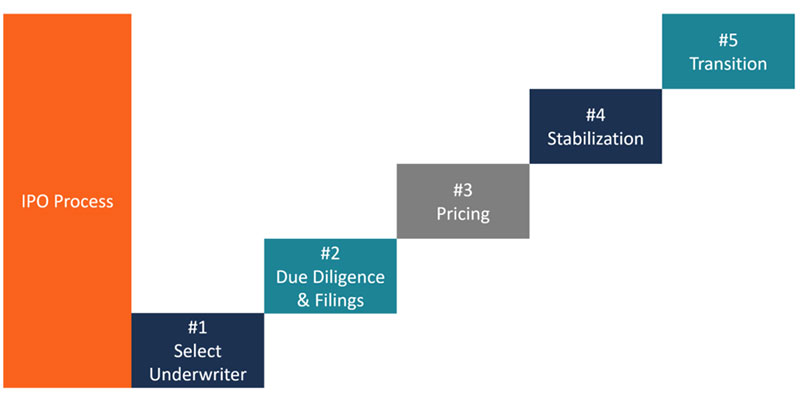Any company that reaches a milestone in its growth process should start thinking about going public. If it is mature enough, and it can pass SEC regulations, a company can begin to promote the idea of being open. Here the IPO process starts to kick in and we will explore soon what it stands for.
This stage usually happens when a company reaches a valuation of around $1 billion. In the business world, this is known as the unicorn status. In this article, we will explain in more detail about the unicorn status, as well as the IPO process you need to go public.
What is an IPO Process?
 Image source: corporatefinanceinstitute.com
Image source: corporatefinanceinstitute.com
In simple terms, a public company is one that can be traded on the stock markets. What this means is that the power is out of the hands of the few investors that owned the company when it was just private. When it goes public, it is pretty much publicly owned.
Before an IPO process, a company is private. This means it has a low number of shareholders; it is limited to accredited investors or early investors only. When an IPO is done, we are referring to the process of offering shares of private corporations to the public using a new stock. What this does is allow a company to raise capital from public investors.
The switch from a private company to a public one is important for private investors because it is a chance to get their investment back. It also lets public investors join the offering. The initial IPO is where a previously unlisted company sells new or existing securities and offers them to the public.
This is a big step for a company because it allows it to grow financially. This helps the company grow and expand, and the increased transparency and share listing is also a major factor in obtaining better terms when borrowed funds are needed.
Taking A Company Public, the IPO Process
As you can imagine, the process of getting a company through its IPO takes some time. It is expensive and can pass different regulatory hurdles. Another important component is to go public and open the information to the public.
Usually, an investment banker or underwriter helps a company go through this process. So what are the steps?
Select an Investment Bank
One of the first things in the IPO process is to choose an investment bank. The role of an investment bank is to advise the company on its IPO and to offer underwriting services. An investment bank should be selected using the following criteria:
- Reputation
- Quality of Research
- Industry expertise
- Distribution
- Relationship with the investment bank
Ongoing Due Diligence
After meetings start to happen, all the parties involved need to do a lot of due diligence for the company to make sure their registration statements are accurate. Aside from the lockup, some other tasks include:
- Customer service calls.
- Market Due Diligence to understand the direction.
- Legal and IP Due Diligence is a task usually performed by lawyers when they check contracts, registrations, and other documents.
File the company prospects for an official review
Now, the company needs to complete some documents related to the Securities and Exchange Commission. In these documents, investors need to see and know all risk factors and any financial statements. As the initial public offer process is taking place, more and more people get involved.
Revisions and discussions are going to take place between the company and its bankers. The goal is to reach the final legal formal document that is completed with the SEC. This will allow the IPO process to continue.
A known document that is common in this step is Form S-1, the formal registration statement under the Securities Act of 1993. Other “S” versions exist, and they are also connected with employee plans or real estate companies. Sometimes, this includes hundreds of pages containing redundant information. However, investors must use and understand what the company does.
The Road Show

The Road Show is a very important IPO process step. When SEC offers its comments, and the company’s registration statement is complete, the investment banks have finished their part; they receive the internal committee approvals things are almost done. The company is now ready to go on a roadshow.
A roadshow is a series of presentations conducted in different locations, each talking about the IPO. Usually, they take around two weeks, and the lead investment bank takes the company’s management around the country. They set different meetings with institutional investors to generate interest.
The team that goes on the roadshow is composed of members of the investment firm that are performing the IPO. Therefore, they travel and explain the opportunity; they want to generate excitement and interest. A roadshow is a very important step in the success of the IPO process.
Define the Number and Price of a Share
This step of the IPO process can be very difficult and requires a lot of knowledge and understanding. No formula can be used to determine the right number of price of shares. The main goal is that the investment bank needs to offer a high enough price so that the issuing company can raise a satisfactory amount of money and have enough low price so that individual investors can purchase the shares.
It may sound difficult, but a good initial public offering has three steps:
- Shares get sold to the underwriters.
- Underwriters sell the share to institutional investors that put orders in the roadshow by selecting groups of investors.
- Shares start to be treated on the exchange.
As this is quite a complicated process, the IPO price is going to be different from the price of the first trade that takes place on an exchange.
Stabilization
When the IPO process is finished, there are still many things that need to happen. One of them is price stabilization, and it happens with the price goes below the IPO price. This is a sign of a struggling IPO.
When a company goes public, it is going to vet several underwriters. They should all have expertise in valuing the company’s equity, marketing, and distribution, together with the sell-side research support.
Transition to Market Competition
This is the final step of the IPO process, and it consists of calibrating the share price. Usually, it starts 25 days after the IPO.
The underwrites provide estimates related to the company’s earnings. By doing so, they help investors as they transition to relying on public information about the company. Six months after IPO, any inside investors are free to sell their shares.
Why Do an IPO?
There are many reasons why companies choose to go public. The most common one is related to funds. Sometimes, certain companies just cannot raise any more funds from their private investors.
Some companies may want to gain more exposure to the public, while others want to offer better terms for individual investors. Reasons vary from company to company, but what is constant is that the reason needs to be strong enough to keep the motivation levels high using the IPO process.
IPO can be a great opportunity for a business to bring large amounts of revenue. Doing so can help them to hire more staff, or even buy other firms. There have been cases where private companies are under pressure from their original investors, and in these cases, they might insist on taking a company public to make a profit.
Some investors do know that another company can do another option to see a return if the private company is purchased. However, this option is not always available. This happens because a company can get big enough not to be bought by another. Sometimes, the bigger a company becomes, the fewer options for exit are available. Therefore, the public market is often used.
FAQs about the IPO process
1. What is an IPO?
A privately owned firm can generate funds through an initial public offering (IPO), in which it first makes shares of its stock available to the general public.
As a result, the business is now a publicly traded entity and stock exchanges can be used to buy and sell its shares.
2. Why do companies go public through an IPO?
To generate money for expansion and growth, businesses go public through an IPO.
It may also offer a way for the company’s founders and early investors to cash out by selling their shares and making a profit. A company’s visibility and brand awareness may rise as a result of becoming public, which may result in more business prospects.
3. What is the process of an IPO?
The Securities and Exchange Commission (SEC), writing a prospectus, filing it, determining a price range for the shares, and finally making the shares available to the general public through the stock exchange are all common processes in the IPO process.
4. How long does it take for a company to complete an IPO?
A variety of variables, including the size of the firm, the difficulty of the offering, and the regulatory procedures involved, can affect the timetable for an IPO.
The time it takes to complete an IPO might range from a few months to more than a year.
5. What are the requirements for a company to go public through an IPO?
A company must fulfill a number of conditions established by the SEC and the stock exchange it intends to list on to go public through an IPO.
A few examples of these conditions include adhering to certain regulatory filings, having a minimum number of shareholders, and following specific financial and accounting standards.
6. What are the advantages and disadvantages of going public through an IPO?
Going public via an IPO has benefits such as obtaining money for expansion, boosting visibility and brand recognition, and giving early investors liquidity.
Going public, however, also entails more stringent regulatory compliance and reporting obligations as well as the possibility of exposing the business to stock market volatility.
7. What is an underwriter and what role do they play in an IPO?
An investment bank that supports a company in planning and carrying out an IPO is known as an underwriter.
Typically, underwriters help with prospectus creation, share pricing, and marketing the offering to prospective investors.
8. How is the price of a company’s shares determined during an IPO?
During an IPO, a procedure called book building is often used to determine the price of a company’s shares.
To ascertain the demand for the shares, underwriters will ask for bids from prospective investors. Based on this demand and other market variables, underwriters will then fix the price.
9. Can anyone participate in an IPO?
Although anybody can technically participate in an IPO, in reality, institutional investors and high-net-worth individuals often hold the majority of IPO shares.
Through their broker, retail investors can occasionally take part in an IPO, but there are frequent limitations and a restricted number of shares available.
10. What are some potential risks that investors should consider before investing in an IPO?
Investing in an IPO can be dangerous because the firm is frequently unproven in the public markets and there may not be enough information to make informed selections.
Also, there is sometimes tremendous price volatility in the initial stages of an IPO, which can cause investors to lose a lot of money.
Before investing in an IPO, investors should carefully weigh the risks and potential returns.
Ending thoughts on the IPO Process
In conclusion, the IPO process is quite complex, and without significant effort, it cannot be done quickly. Companies that choose to do this have a lot of resources available and can manage the entire process without having big problems.
If you enjoyed reading this article on the IPO process, you should check out this one about Steve Jobs’s leadership style.
We also wrote about a few related subjects like IPO lockup period, risk assessment matrix, business process modeling, business model innovation, business model vs business plan, accelerator vs incubator, startup funding stages, and how to value a startup.
- What Are Third-Party Cookies and How They Work - April 20, 2024
- How Do Websites Detect Adblock? It’s Quite Simple, Actually - April 14, 2024
- Financial Software Development Companies You Should Know - April 11, 2024









